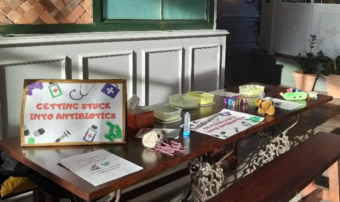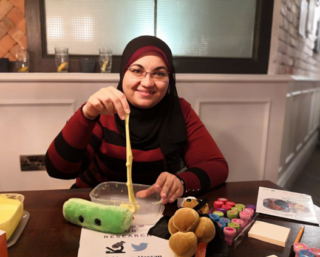Getting stuck into antibiotics at the British Science Festival
Posted on February 25, 2020 by Marwa Hassan
Between Tuesday 10 and Friday 13 September, the British Science Festival Coventry and Warwickshire took place, with a diverse programme of talks, debates and activities taking place around the city. Research Fellow at the University of Warwick and Microbiology Society Champion, Dr Marwa Hassan hosted a stand at the festival, where she helped to educate the public about biofilms and antimicrobial resistance.

Seize the opportunity
When I heard that the British Science Festival (BSF) was accepting applications for the 2019 Coventry event, I was so excited. I love science communication as it inspires me to think of a simple analogy or approach to explain the complicated research questions I work on. As a researcher, it helps me connect my work to the overall picture and step outside the complex technical details which I so often focus on.
When I applied, I pictured myself giving an interactive talk, with a two-way conversation with the audience, rather than a more traditional lecture-style talk. I conceived and planned this idea, sent the application to colleagues for feedback and finally submitted it. My application was accepted but not for my original plan; not for a talk and certainly not the way I originally hoped for. I was offered a stand at The Botanist in Coventry and needed to plan a different style of activity to engage with the public in a completely different setting. My first feelings were happiness and excitement to be contributing to such a big science event in my first year in the UK, but I was also overwhelmed that I needed to start thinking of some new outreach ideas.
Take your time to think
What is your take home message? It all came down to what do I want to tell the public. What do I want them to learn? What are the misconceptions that I want to correct/highlight?
I decided that the key message I wanted to convey is how antibiotics work and how bacteria develop resistance. I also thought it was important to communicate this in the context of cystic fibrosis. To explain this properly, I had to also explain what a bacterial biofilm is and why simple infections may be easier to treat than biofilm-based infections.
This was a lot of information to pass on in few minutes, meaning our activity had to have a good analogy and be very visual. As a visual learner and teacher, I couldn’t stop thinking about it and after few conversations with others, we finally developed the idea!

The idea
Simply, our activity was making a slime containing metal beads. This represented bacterial biofilms with the bacteria being the beads. Then, guests used a small magnet to try and pull the beads out of the slime. This magnet represented antibiotics and showed how difficult it is to reach bacteria in the biofilm – even if participants were able to reach a few, there were more protected by the biofilm matrix (the slime).
This was brilliant because it even gave us the chance to colour the biofilm and talk about different bacterial toxins and virulence factors…the conversation could carry on forever. In parallel, guests were able to use the same magnet to remove beads from water to represent a simple infection with no biofilm.
The obstacles
Making slime seemed very easy when watching online videos, what could go wrong? When we tried it out, it did not work, and we failed many times. But, with a bit of research and troubleshooting, we figured it out and solved the problem – we are researchers after all! We found that you should never trust a borate-less recipe because boric acid is what interacts to make the slime.
On the day
"Do you want to be an antibiotic today?" was what we asked the guests who came to our stand. "I might not be very effective" was what some replied. It was so much fun and we were able to explain how and why bacteria evolve to become resistant. People were astonished by how smart these small microbes are.
The main surprise was the slime and how visual it was to explain bacterial biofilms. After the activity, guests could easily guess the lack of efficiency of antibiotics in biofilm infections and the reasons behind. Some had heard about cystic fibrosis but could not really remember what it was, and some were not aware of this disease at all. Many asked about how bacteria behave, how they interact, whether phage therapy can help…the conversation actually never ended.
Thanks
Thanks goes to the British Science Festival committee members who never stopped following up, answering all my inquiries and funding and supporting the activity. I would also like to thank the public engagement team at the University of Warwick and the School of Life Sciences for their support and Niamh Harrington for help in the activity, is really appreciated.

